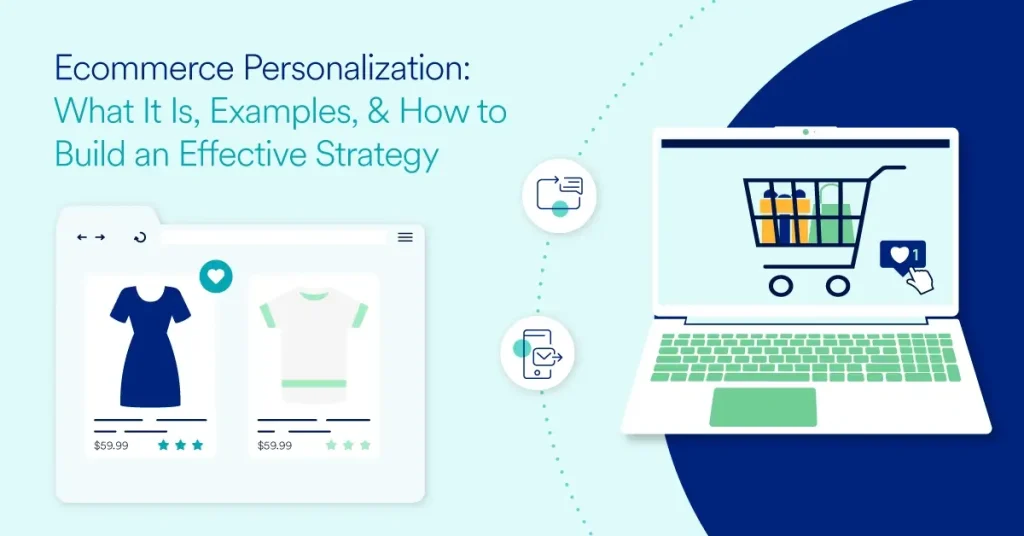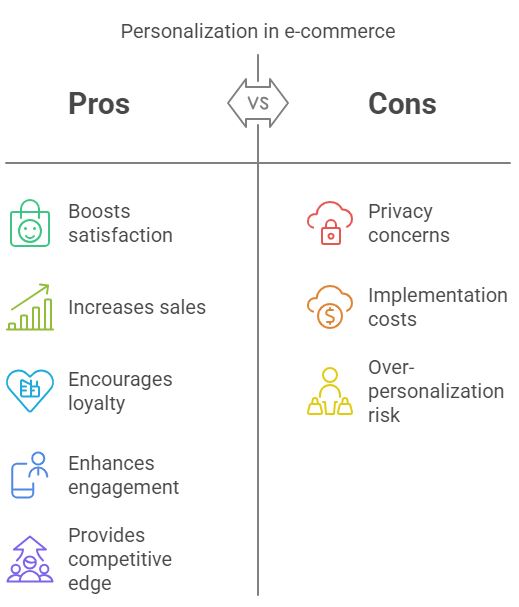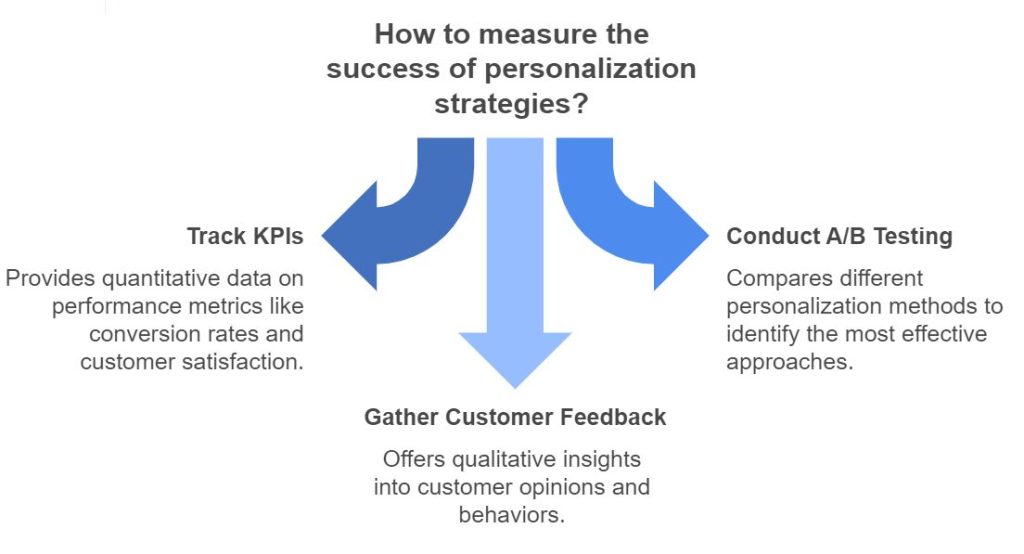- Research platform
Sources of information
Data analysis
Actions
- Solutions
For whom
Problems / Issues
- Materials
Materials
- About us
About us

What is personalization in e-commerce? It changes how businesses connect with customers during their online shopping journeys. Personalization means adjusting products, suggestions, and marketing messages to match individual customer needs and behavior. The use of personalization in e-commerce helps improve customer satisfaction.
An ecommerce personalization platform plays a crucial role in tailoring offerings based on customer browsing history, leading to increased relevance of suggestions and a higher chance of returning customers.
This post looks into the aspects of personalization in e-commerce with examples and highlights the importance of data in making tailored offerings. You will see how brands use CX data to make shopping special, the variances between personalization and customization in e-commerce, and the benefits of strong personalization strategies. Also, we will explore the hurdles businesses face when incorporating personalization. Customers expect personalized shopping experiences across all digital touchpoints, making it essential for businesses to adapt. So, read on to learn how personalized offers can boost your e-commerce presence and engage your customers.
Customer behavior in e-commerce personalization involves customizing shopping experiences, product suggestions, and marketing content for each customer based on their behaviors and preferences. It gathers data on individual customers like browsing habits and purchase history. This creates useful and engaging experiences that can boost satisfaction.
One effective personalization tactic is leveraging customer data to create tailored content and product recommendations. Customer data serves a vital role in e-commerce personalization. By analyzing data points, businesses spot trends and preferences, which helps them predict what customers might need. They can give tailored offers that match individual interests. For instance, if a customer regularly looks at sporting goods, specific ads may focus on those types of products, making them feel uniquely catered to. Additionally, loyalty programs use customer data to offer personalized rewards and enhance customer retention by tailoring incentives based on individual shopping behaviors and the customer's preferences.
Compared to basic segmentation that groups customers broadly, personalization targets the person. Segmentation might target based on age or location but personalization focuses on individual behaviors and histories. Identifying and targeting high value customers, who contribute significantly through high lifetime value and purchase frequency, can further enhance personalization strategies. This focused approach results in better communication that resonates on a deeper level. Such precision can increase conversion rates and loyalty.
Brands that effectively use personalization strategies tend to see higher customer retention and retain customers. Data shows that custom recommendations may boost conversion by around 300%. A personalized experience significantly enhances customer engagement, leading to improved conversion rates and customer loyalty. Such figures demonstrate how crucial it is to personalize every contact point throughout the e-commerce journey. Offering a personalized experience provides a competitive advantage in a saturated market.
What is personalization in e-commerce? For an ecommerce business, it’s essential for improving customer journey and boosting sales. Digital shopping grows, so businesses create unique experiences for every shopper based on their actions and choices. Personalized product recommendations stand out.
These are built using algorithms analyzing past buying actions and browsing habits. Create personalized bestseller lists to showcase popular products tailored to specific audiences, such as top items in a given location or time period. Utilizing previous purchases allows businesses to make effective cross-sell and upsell recommendations, increasing average order values. Things aligned with buyers’ interests appear, making them more likely to buy. Personalization helps in getting customer loyalty too. Personalized experiences build strong emotional bonds, and tailored product recommendations can significantly boost the average order value.
For example, people enjoy getting tailored discounts or promotions. Businesses can offer tiered discounts based on visitor behavior, such as cart value and session activity, to enhance customer engagement. This makes them feel special, and they are likely to return. Research shows 74% of shoppers get upset with non-personalized website content. Customized emails also serve as a great way of personalizing experience. Additionally, personalization can significantly reduce cart abandonment rates through reminder strategies, such as sending follow-up emails with the items left in the cart or offering limited-time discounts to encourage completion of the purchase. Implementing personalized email campaigns can lead to significantly higher transaction rates and improved customer satisfaction.
Using data, brands highlight relevant items or offer special deals in emails. Leveraging first-party data collected directly from customers can significantly enhance personalization strategies by providing deeper customer insights. By utilizing dynamic pricing, online retailers can adjust prices based on various factors such as customer demographics, browsing behavior, and market demand. First-party data, collected with customer consent, ensures compliance with privacy regulations while enabling businesses to create more accurate and effective personalized experiences. This increases engagement from users. Keeping up talks with customers can help brands gain more opens and clicks than standard emails would. Real-time personalization is also changing how e-commerce sales connect with its users.
Advanced analytics allows firms to act on new data fast. It provides appropriate items or alters ads based on visible behaviors. This method not only makes customers happier but also increases sales, creating a better shopping space. Personalization in e-commerce is now crucial for brands aiming to do well in the market. Ecommerce personalization trends like machine learning and AI can further enhance real-time personalization by analyzing visitor behavior and tailoring the shopping experience dynamically. By focusing on each visitor's in session behavior, businesses can offer timely and personalized experiences that boost user engagement and conversion rates.
To grasp what personalization in e-commerce really means is key for benefiting from it. Personalization and customization in e-commerce focus on adjusting the shopping experience for individual customer needs and choices. Various ecommerce platforms offer tools for effectively segmenting traffic and tailoring unique shopping experiences for different user segments. Ecommerce personalization examples from major online retailers showcase how personalized strategies can lead to a unique shopping journey. Below are some examples demonstrating these strategies:
Targeted ads based on browsing patterns: Online sellers utilize cookies and tracking tools to analyze a customer’s browsing habits. They can then display personalized ads based on products or categories the target users have shown interest in. This method often results in more effective advertising with higher click-through rates.
These examples clearly show how personalization and customization can create a more engaging shopping experience for everyone. By utilizing customer data smartly, businesses can boost conversion rates and engender loyalty, paving the way for the many advantages that personalization in e-commerce provides. Additionally, personalized search can enhance user experiences by tailoring search results based on user data, such as location and past interactions, leading to increased sales and customer satisfaction.

What is personalization in e-commerce? It’s key to boosting customer satisfaction and building loyalty by effectively targeting different segments of the customer base. When people know their needs get met, they connect better with the brand. Studies show that personalized experiences can give a 20% uptick in customer satisfaction ratings. This tells us how vital it is to cater to individual consumer needs. Brands that offer personalized experiences see higher customer satisfaction and increased sales, as customers feel recognized and catered to.
Ecommerce sales can be significantly boosted through the use of personalization, which also helps conversion rates and increases order values. Businesses using personalized recommendations notice a sales spike. About 39% of shoppers say they buy more if they see a tailored experience. Personalized product recommendations can increase average order values by up to 12%, showcasing the financial benefits of tailoring suggestions to individual preferences. So, they not only buy but also spend more when they see suggestions matching their interests. Implementing personalized bestseller lists tailored to specific demographics can boost user engagement and drive conversions. Brands offer personalized experiences to meet customer expectations and drive sales, leveraging advanced technologies like AI and machine learning to customize interactions.
Encouraging repeat visits is critical too. Personalization enhances experiences, which brings customers back, while avoiding the inclusion of inactive customers in targeted efforts. Reports show that 71% of people feel annoyed when shopping isn’t personalized. It shows brands must engage customers better. Tailored messages and promotions keep customers returning, which boosts lifetime value.
Ecommerce brands that excel in personalization generate a competitive edge in today’s busy market. Brands that do it well stand out from those with generic experiences. By crafting a personalized shopping journey, firms attract customers. Some studies note that 80% of consumers are likely to make a purchase if they see personalized offerings. Companies that grow faster achieve 40% more revenue from personalization than their slower counterparts, highlighting the importance of investing in tailored customer experiences. This edge is essential when choices abound. Developing an ecommerce personalization strategy is crucial to enhance customer engagement and drive brand loyalty.
What is personalization in e-commerce? It’s about tailoring experiences to fit individual needs. Despite its benefits, many companies encounter obstacles when applying personalization effectively. It’s key to recognize these challenges for better customer experiences. Creating personalized experiences for loyal customers can significantly enhance retention and satisfaction.
A major problem arises from data silos. Businesses often face issues in integrating information from various sources. Customer interactions, transaction history, and feedback data remain separate. This lack of unity makes understanding the whole customer journey difficult. Therefore, providing personalized experiences is tougher. Personalizing the ecommerce store can enhance customer experiences and expectations in online retail. Effective data collection is crucial in overcoming these data silos and enhancing personalization efforts on an ecommerce site.
Privacy issues create big hurdles too. Laws like GDPR and CCPA impose strict rules on how organizations gather, store, and use customer data. They require clear consent, making it challenging to collect the data needed for effective personalization. Non-compliance can lead to serious legal trouble and impact a brand’s reputation negatively.
Data quality is very important. For effective personalization and customization in e-commerce, businesses need accurate and consistent data. If data is poor quality, personalization efforts might miss the mark, leading to unhelpful recommendations. Investing in data maintenance and management is crucial for success. Accurate data helps in understanding customer’s preferences and improving personalization efforts, ultimately creating an effective personalized ecommerce experience.
Achieving a balance between personalization and user experience proves difficult. Too much personalization risks feeling intrusive and might push customers away instead of engaging them. Brands need to find the right amount of information to personalize offers carefully. This detail work ensures a positive user experience while still using data wisely.
As companies confront these issues, recognizing the importance of data in enhancing personalization in e-commerce is vital. By prioritizing effective data management and compliance, along with strategic personalization techniques, brands may overcome challenges. This approach leads to improved customer experiences and satisfaction.
Online shoppers are at the heart of personalization efforts in e-commerce, with data shaping unique shopping journeys that align with individual customers’ likes and habits. The way businesses use customer data goes beyond simple demographic groups; it helps them provide distinct experiences based on live customer actions. An effective ecommerce platform allows for dynamic content personalization, improving user experience based on individual customer data. By analyzing browsing and purchase history, brands can tailor product recommendations to suggest similar or complementary products, ultimately driving larger basket sizes and enhancing the shopping experience.
Ecommerce businesses can greatly benefit from customer relationship management systems as a major source for data in personalization. These systems gather differing customer data points such as buying history, browsing habits, and customer opinions. This approach gives e-commerce firms a complete understanding of their users, which is vital for crafting customized suggestions and marketing methods. Understanding and leveraging customer’s preferences can significantly enhance the personalization of services and product recommendations. Integrating an ecommerce personalization platform with CRM systems can further enhance personalization efforts by tailoring offerings based on customer browsing history, leading to increased relevance of suggestions and a higher chance of returning customers.
Real-time data plays a vital role in adjusting offers to fit the needs of prospective customers that change. For example, a shopper who often looks at winter clothing might get special deals on those items, which reflects their interests at that moment. This immediacy increases relevance and the chance of making a sale. Actually, data-based personalization can boost sales by 20%, showing the power of swift, personalized interactions. Analyzing each visitor’s in-session behavior, such as shopping cart value, time spent on the site, and browsing patterns, can further enhance real-time personalization efforts by triggering targeted promotions that drive conversions.
In addition, combining data from different sources like website analytics and social media enhances the strategies for personalization in an online store. Website analytics give details on how visitors move through sites, pinpointing areas of strong interest and where they leave. Social media can show how customers feel and new trends, enabling brands to refine their methods quickly to stay current in fast-paced markets. By using these various data sources, e-commerce companies can create a story about their products designed to appeal to specific audience tastes. Ecommerce companies can benefit significantly from integrating multiple data sources to enhance personalization, leading to improved customer engagement and loyalty.
As we delve into the challenges of applying personalization strategies, it’s clear effective data use needs to be central to these actions. Using thorough data not only improves customer happiness but also builds loyalty by meeting changing customer needs.
CRMs are essential tools for managing customer data effectively. These systems track interactions and provide insights for customizing offers and messages.
Marketing strategies involving AI and ML technologies enable advanced personalization. They analyze data, predict behaviors, and automate personalization efforts.
Additionally, marketing automation can enhance personalization efforts through AI and machine learning by streamlining product discovery and content management, ultimately facilitating targeted customer journeys across various touchpoints.
Dedicated platforms enable focused personalization efforts. These platforms help manage and optimize experiences across all customer touchpoints.

Tracking metrics like conversion rates, click-through rates, and customer satisfaction helps measure personalization success. By monitoring these KPIs, businesses can refine and improve their personalization efforts.
Using A/B testing to compare different personalization methods allows companies to find the most effective approaches. Testing provides valuable insights for optimizing and improving personalization strategies.
Gathering customer feedback about personalized experiences through tailored landing pages is crucial. Surveys, reviews, and comments provide valuable insights into what works and what doesn’t. For a comprehensive understanding of customer opinions and behaviors, consider leveraging platforms like YourCX.io. YourCX.io offers advanced tools for collecting and analyzing customer feedback, enabling businesses to fine-tune their personalization efforts for optimal results and enhanced customer satisfaction.
AI will continue to shape personalization efforts, enabling a more sophisticated and predictive personalized shopping experience. AI algorithms will deliver real-time recommendations tailored to individual customer needs.
Personalization campaigns can be enhanced through AI-driven insights, allowing businesses to better understand and cater to diverse demographics and preferences.
Hyper-personalization, which involves customizing every aspect of the shopping experience, is on the rise. This approach adapts to very detailed data points to offer experiences that feel uniquely suited to each customer.
As personalization becomes more advanced, it is crucial to address ethical concerns. Transparency, data privacy, and responsible data practices will be essential for maintaining customer trust and loyalty.
In conclusion, the strategic use of personalization in e-commerce transforms how businesses interact with customers, leading to enhanced customer satisfaction, improved conversion rates, and strengthened loyalty. Businesses must understand the nuances of personalization, use data responsibly, and embrace technology to craft customized experiences. Those who prioritize personalization will gain a significant competitive edge, fostering lasting relationships with their customers in an increasingly competitive online landscape.
Copyright © 2023. YourCX. All rights reserved — Design by Proformat